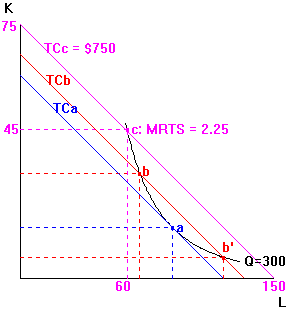| You are the manager of the Axes Corporation which uses labor (L) and capital (K) to produce X and Y axes for course diagrams. The price of workers is $5 per unit and the price of capital is $10 per machine. You have orders to produce 300 axes and have the following information about your production: | |||||||||||||||||||||||||||||||||||||||||||||||||||||||||||||||||||
|
|||||||||||||||||||||||||||||||||||||||||||||||||||||||||||||||||||
| Each case above corresponds to either point a, b, or b' in
the diagram to the right. Decide which case goes with which point, and then label the
diagram with each of the following numerical values: (1) quantity of L (2) quantity of K (3) TC (4) L-axis endpoint of the isocost line (5) K-axis endpoint of the isocost line, and (6) MRTS. Similar information for point c is provided as an illustration. |
 |
||||||||||||||||||||||||||||||||||||||||||||||||||||||||||||||||||